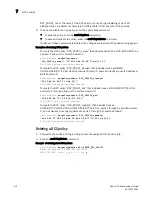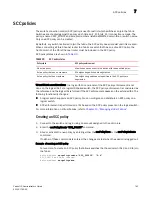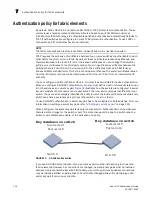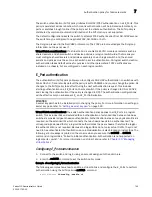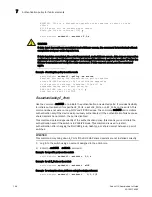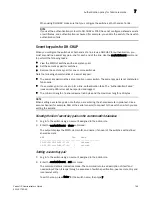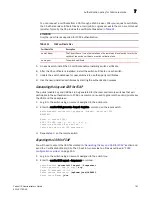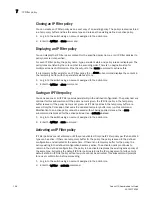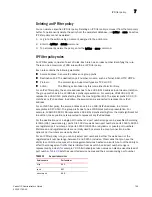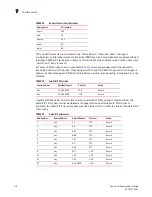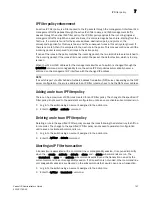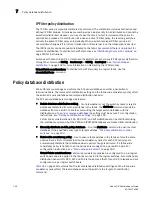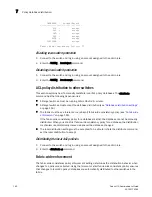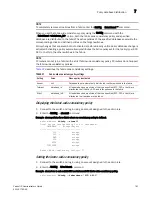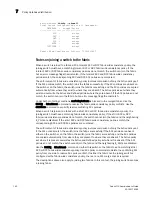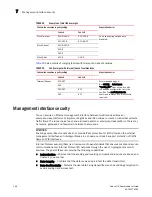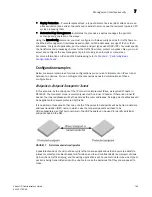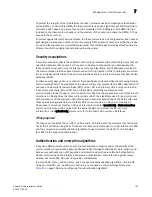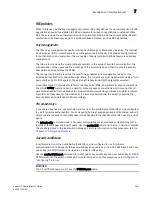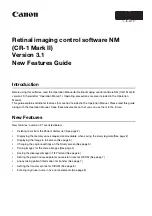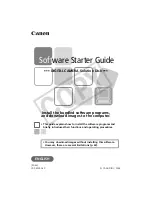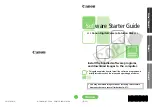
Fabric OS Administrator’s Guide
155
53-1001763-02
IP Filter policy
7
Deleting an IP Filter policy
You can delete a specified IP Filter policy. Deleting an IP Filter policy removes it from the temporary
buffer. To permanently delete the policy from the persistent database, run ipfilter
--
save. An active
IP Filter policy cannot be deleted.
1. Log in to the switch using an account assigned to the admin role.
2. Enter the ipFilter
-–
delete command.
3. To permanently delete the policy, enter the ipfilter
--
save command.
IP Filter policy rules
An IP Filter policy consists of a set of rules. Each rule has an index number identifying the rule.
There can be a maximum of 256 rules within an IP Filter policy.
Each rule contains the following elements:
•
Source Address: A source IP address or a group prefix.
•
Destination Port: The destination port number or name, such as: Telnet, SSH, HTTP, HTTPS.
•
Protocol:
The protocol type. Supported types are TCP or UDP.
•
Action:
The filtering action taken by this rule, either Permit or Deny.
For an IPv4 filter policy, the source address has to be a 32-bit IPv4 address in dot decimal notation.
The group prefix has to be a CIDR block prefix representation. For example, 208.130.32.0/24
represents a 24-bit IPv4 prefix starting from the most significant bit. The special prefix 0.0.0.0/0
matches any IPv4 address. In addition, the keyword
any
is supported to represent any IPv4
address.
For an IPv6 filter policy, the source address has to be a 128-bit IPv6 address, in a format
acceptable in RFC 3513. The group prefix has to be a CIDR block prefix representation. For
example, 12AB:0:0:CD30::/64 represents a 64-bit IPv6 prefix starting from the most significant bit.
In addition, the keyword
any
is supported to represent any IPv6 address.
For the destination port, a single port number or a port number range can be specified. According
to IANA (http://www.iana.org), ports 0 to 1023 are well-known port numbers, ports 1024 to 49151
are registered port numbers, and ports 49152 to 65535 are dynamic or private port numbers.
Well-known and registered ports are normally used by servers to accept connections, while
dynamic port numbers are used by clients.
For an IP Filter policy rule, you can only select port numbers in either the well-known or the
registered port number range, between 0 and 49151, inclusive. This means that you have the
ability to control how to expose the management services hosted on a switch, but not the ability to
affect the management traffic that is initiated from a switch. A valid port number range is
represented by a dash, for example 7-30. Alternatively, service names can also be used instead of
port number.
Table 32
lists the supported service names and their corresponding port number.
TABLE 32
Supported services
Service name
Port number
http
443
rpcd
897
securerpcd
898
Содержание 53-1001763-02
Страница 1: ...53 1001763 02 13 September 2010 Fabric OS Administrator s Guide Supporting Fabric OS v6 4 0 ...
Страница 4: ...iv Fabric OS Administrator s Guide 53 1001763 02 ...
Страница 24: ...xxiv Fabric OS Administrator s Guide 53 1001763 02 ...
Страница 28: ...xxviii Fabric OS Administrator s Guide 53 1001763 02 ...
Страница 32: ...xxxii Fabric OS Administrator s Guide 53 1001763 02 ...
Страница 40: ...xl Fabric OS Administrator s Guide 53 1001763 02 ...
Страница 42: ...2 Fabric OS Administrator s Guide 53 1001763 02 ...
Страница 54: ...14 Fabric OS Administrator s Guide 53 1001763 02 High availability of daemon processes 1 ...
Страница 74: ...34 Fabric OS Administrator s Guide 53 1001763 02 Basic connections 2 ...
Страница 102: ...62 Fabric OS Administrator s Guide 53 1001763 02 Audit log configuration 3 ...
Страница 156: ...116 Fabric OS Administrator s Guide 53 1001763 02 The authentication model using RADIUS and LDAP 5 ...
Страница 214: ...174 Fabric OS Administrator s Guide 53 1001763 02 Management interface security 7 ...
Страница 228: ...188 Fabric OS Administrator s Guide 53 1001763 02 Brocade configuration form 8 ...
Страница 276: ...236 Fabric OS Administrator s Guide 53 1001763 02 Creating a logical fabric using XISLs 10 ...
Страница 404: ...364 Fabric OS Administrator s Guide 53 1001763 02 ...
Страница 440: ...400 Fabric OS Administrator s Guide 53 1001763 02 Performance data collection 17 ...
Страница 464: ...424 Fabric OS Administrator s Guide 53 1001763 02 Disabling bottleneck detection on a switch 18 ...
Страница 480: ...440 Fabric OS Administrator s Guide 53 1001763 02 F_Port masterless trunking 19 ...
Страница 494: ...454 Fabric OS Administrator s Guide 53 1001763 02 Buffer credit recovery 20 ...
Страница 560: ...520 Fabric OS Administrator s Guide 53 1001763 02 Port indexing on the Brocade DCX 4S backbone C ...
Страница 574: ...534 Fabric OS Administrator s Guide 53 1001763 02 Hexadecimal overview E ...


